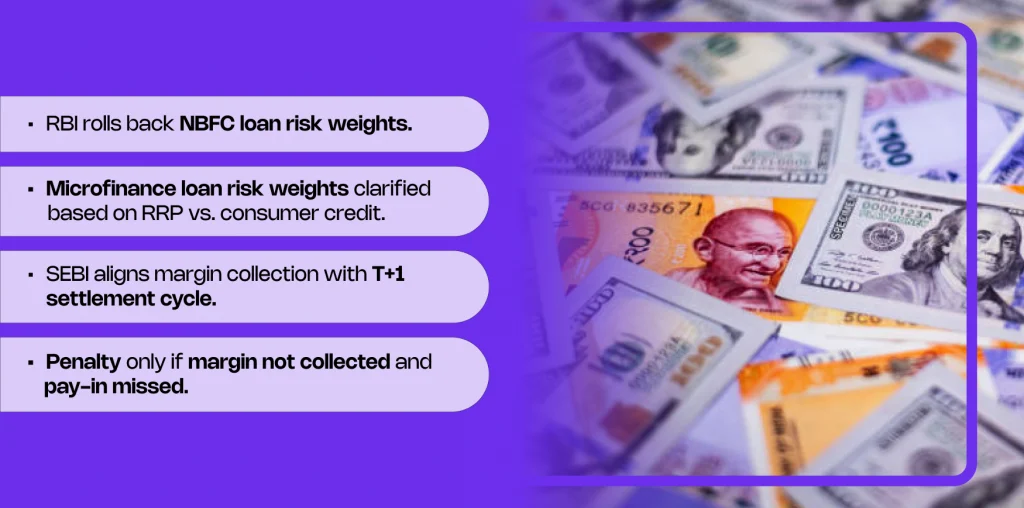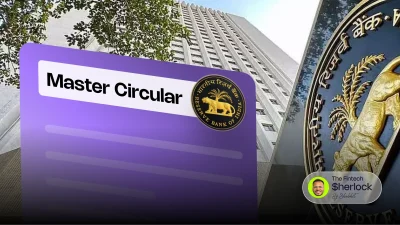The RBI has revised the risk weights for microfinance loans, giving relief to banks and boosting NBFCs by rolling back earlier capital requirements. Simultaneously, SEBI has aligned the deadline for margin collection with the T+1 settlement cycle. Both changes provide clarity, ease operational challenges, and aim to enhance credit flow and market discipline.
The regulatory landscape has seen significant tweaks in response to real-world frictions in implementation. The RBI had earlier raised capital requirements for certain loans, notably to NBFCs and for consumer credit, to counter overheating and credit risks. But this led to a sharp dip in credit growth, especially toward NBFCs and microfinance.
On the securities side, SEBI’s earlier rules for collecting upfront margins didn’t line up well with the new T+1 settlement cycle. This led to confusion among brokers and traders, especially around when penalties would apply.
After hearing concerns from the industry, SEBI has now stepped in to clear things up. The updated rules aim to strike a better balance – keeping risks in check while also making day-to-day operations easier for everyone involved.
Key Highlights

RBI Circular: Risk Weights on Microfinance and NBFC Loans
- Rollback on NBFC Loan Risk Weights
- Earlier (Nov 2023): Banks had to apply a 25 percentage point higher risk weight on loans to NBFCs if the external rating implied less than 100%.
- Now (May 2025): These additional risk weights have been rolled back. From April 1, 2025, normal risk weights based on external ratings will apply again.
- Earlier (Nov 2023): Banks had to apply a 25 percentage point higher risk weight on loans to NBFCs if the external rating implied less than 100%.
- What it means: Loans to AAA-rated NBFCs will no longer need a 125% risk weight. It will revert to ~20%, freeing up capital for banks.
- Clarification on Microfinance Loan Risk Weights
- For Commercial Banks (excluding RRBs and LABs):
- If the microloan qualifies as Regulatory Retail Portfolio (RRP): Risk weight is 75%.
- If it is considered consumer credit (not RRP): Risk weight is 100%.
- Previously, some were applying 125%- this is now clarified as incorrect.
- If the microloan qualifies as Regulatory Retail Portfolio (RRP): Risk weight is 75%.
- For RRBs and LABs:
- All microfinance loans will carry 100% risk weight, uniformly.
- All microfinance loans will carry 100% risk weight, uniformly.
- For Commercial Banks (excluding RRBs and LABs):
- Example: A microloan used for business and meeting RRP norms gets the 75% benefit. But a loan used for personal consumption gets 100%.
- Operational Clarity
- Applicable immediately for all outstanding and new loans.
- Banks must have SOPs to categorize loans properly into RRP vs. consumer credit.
- Applicable immediately for all outstanding and new loans.
- Impact of Earlier Policy
- Loan growth to NBFCs dropped from 15% to 6.7% YoY by Dec 2024.
- Overall bank credit growth fell from 20% to 11.2% in the same period.
- Loan growth to NBFCs dropped from 15% to 6.7% YoY by Dec 2024.
SEBI Circular: Margin Collection Aligned to T+1

- Background
- SEBI had earlier allowed TMs/CMs (brokers and clearing members) time till T+2 to collect margins (other than upfront VaR and ELM).
- But India’s equity market has moved to a T+1 settlement cycle from Jan 2023.
- SEBI had earlier allowed TMs/CMs (brokers and clearing members) time till T+2 to collect margins (other than upfront VaR and ELM).
- What’s Changing
- Now, brokers must collect all margins except VaR and ELM by the settlement day itself.
- VaR and ELM still need to be collected before the trade.
- If pay-in is made by settlement day, it is deemed that all other margins were collected. No penalty applies.
- If client fails to pay by settlement, and the broker hasn’t collected other margins, penalty will be imposed.
- Now, brokers must collect all margins except VaR and ELM by the settlement day itself.
- Effective Date
- The SEBI circular is effective immediately (April 28, 2025).
Impact on Fintechs

For NBFCs and Digital Lenders
- More Access to Bank Credit:
- With banks now needing to set aside less capital for NBFC loans, credit flow should improve.
- Especially helpful for NBFCs that were AAA/AA rated but faced higher cost of funds due to 125% risk weight.
- With banks now needing to set aside less capital for NBFC loans, credit flow should improve.
- Immediate Capital Relief for Banks:
- Banks with large NBFC exposure, particularly for microfinance, will now see capital buffers improve.
- That means greater risk appetite and potential growth in digital lending partnerships.
- Banks with large NBFC exposure, particularly for microfinance, will now see capital buffers improve.
- Product Categorization Critical:
- Fintech lenders offering microloans need clarity: Is the loan business-related (RRP) or consumer credit?
- Ensure SOPs, documentation, and system checks align with RRP criteria to access lower risk-weight benefits.
- Fintech lenders offering microloans need clarity: Is the loan business-related (RRP) or consumer credit?
For Capital Market Startups and Brokers
- System Upgrades Required:
- Brokers will need to update margin collection processes to align with the T+1 cycle.
- CRM and back-office systems must alert and collect margins by settlement day, not T+2.
- Brokers will need to update margin collection processes to align with the T+1 cycle.
- No Change in VaR/ELM Rules:
- Upfront collection of VaR and ELM remains mandatory before the trade, as always.
- Upfront collection of VaR and ELM remains mandatory before the trade, as always.
- Avoiding Penalty Traps:
- Clear communication to clients that margin delays – even by a day – could now attract penalties unless pay-in is completed.
Product, Engineering & Legal To-Do List
For Fintechs (Banks/NBFCs/Digital Lenders):
- Classify all microloans: RRP or Consumer Credit?
- Document SOPs and ensure alignment with RBI’s four criteria for RRP.
- Update lending engine and compliance workflows to reflect correct risk weight.
- Train the relationship and credit ops teams to handle dual classification.
For Brokers/Trading Platforms:
- Adjust margin workflows to end on settlement day.
- Modify client communication templates and margin call alerts.
- Ensure audit trails of collection for SEBI compliance.
Deadline Reminders:
- RBI NBFC risk weight rollback → Effective April 1, 2025
- RBI microfinance risk weight classification → Immediate
- SEBI margin alignment → Effective April 28, 2025
Conclusion
These circulars clearly show that RBI and SEBI are paying attention to what the industry is saying. By revisiting earlier rules and making much-needed clarifications – especially around risk weights and margin deadlines – they’ve taken steps that reflect how things actually work on the ground. This makes the entire financial system not only more secure but also a lot easier to work with.
For fintechs, this is a good time to take stock of how your systems and teams are set up. With the confusion around compliance now cleared up, there’s room to simplify operations, make smarter product decisions, and move forward with confidence, knowing the rules are finally aligned with practical realities.




